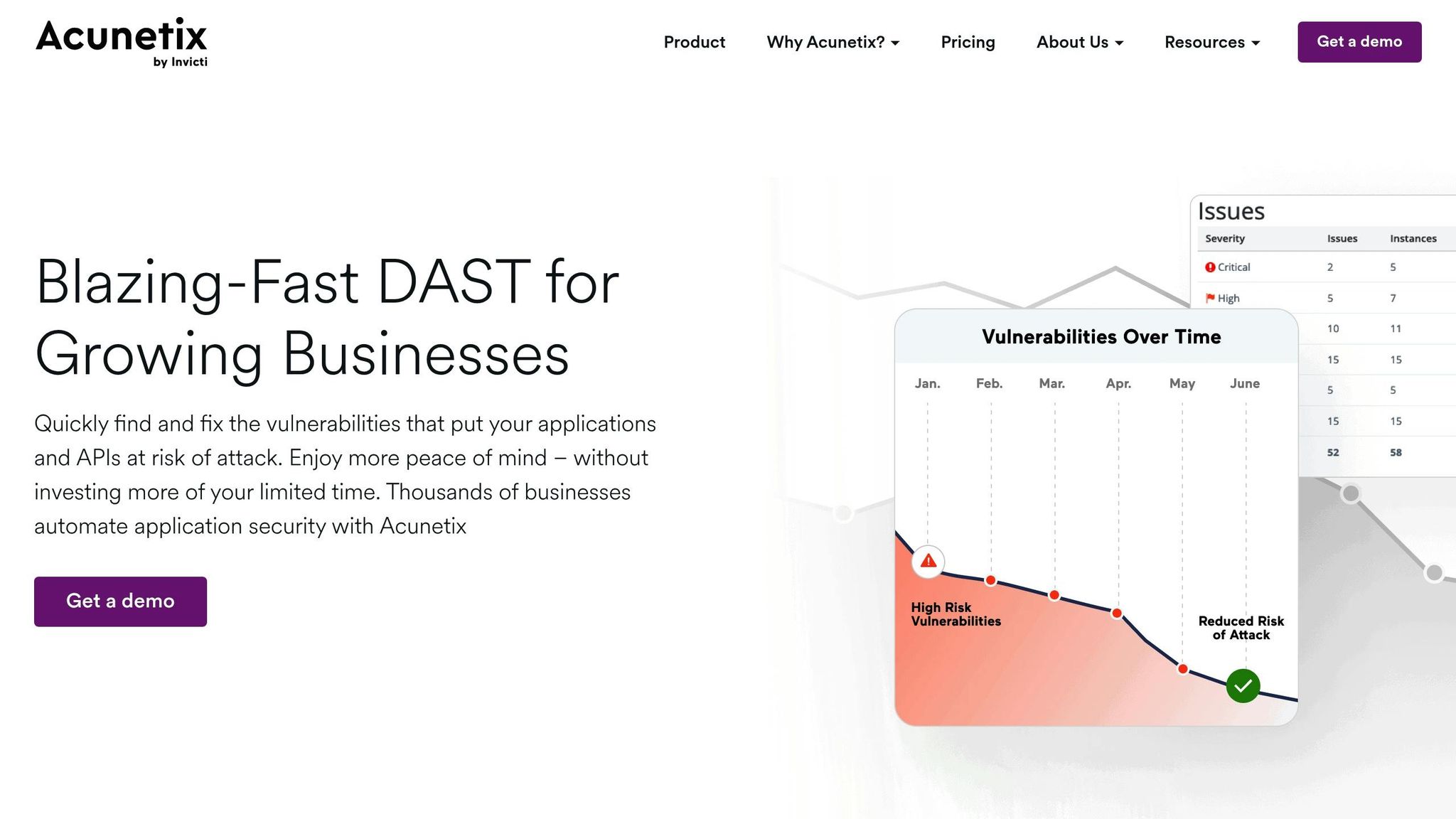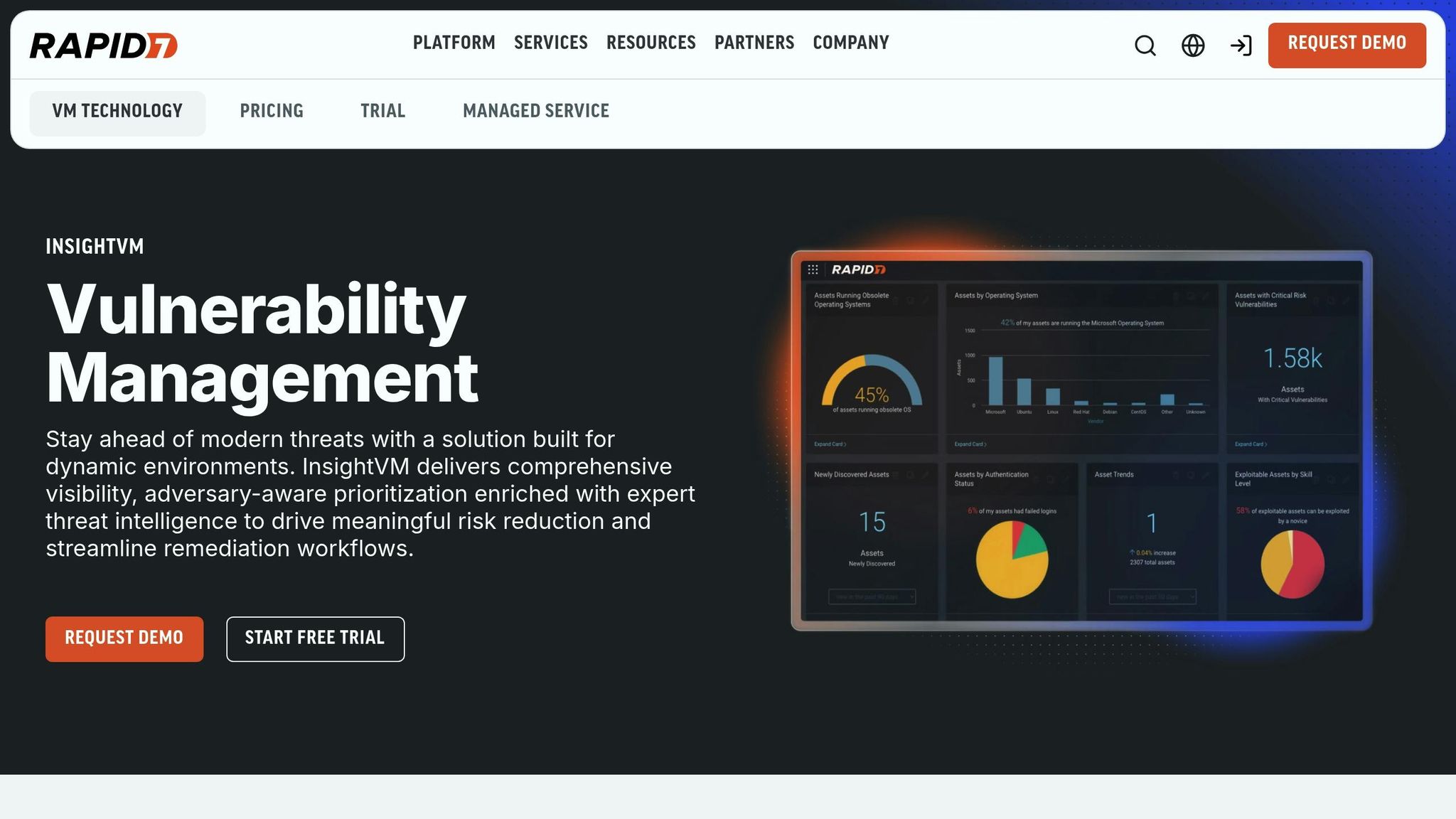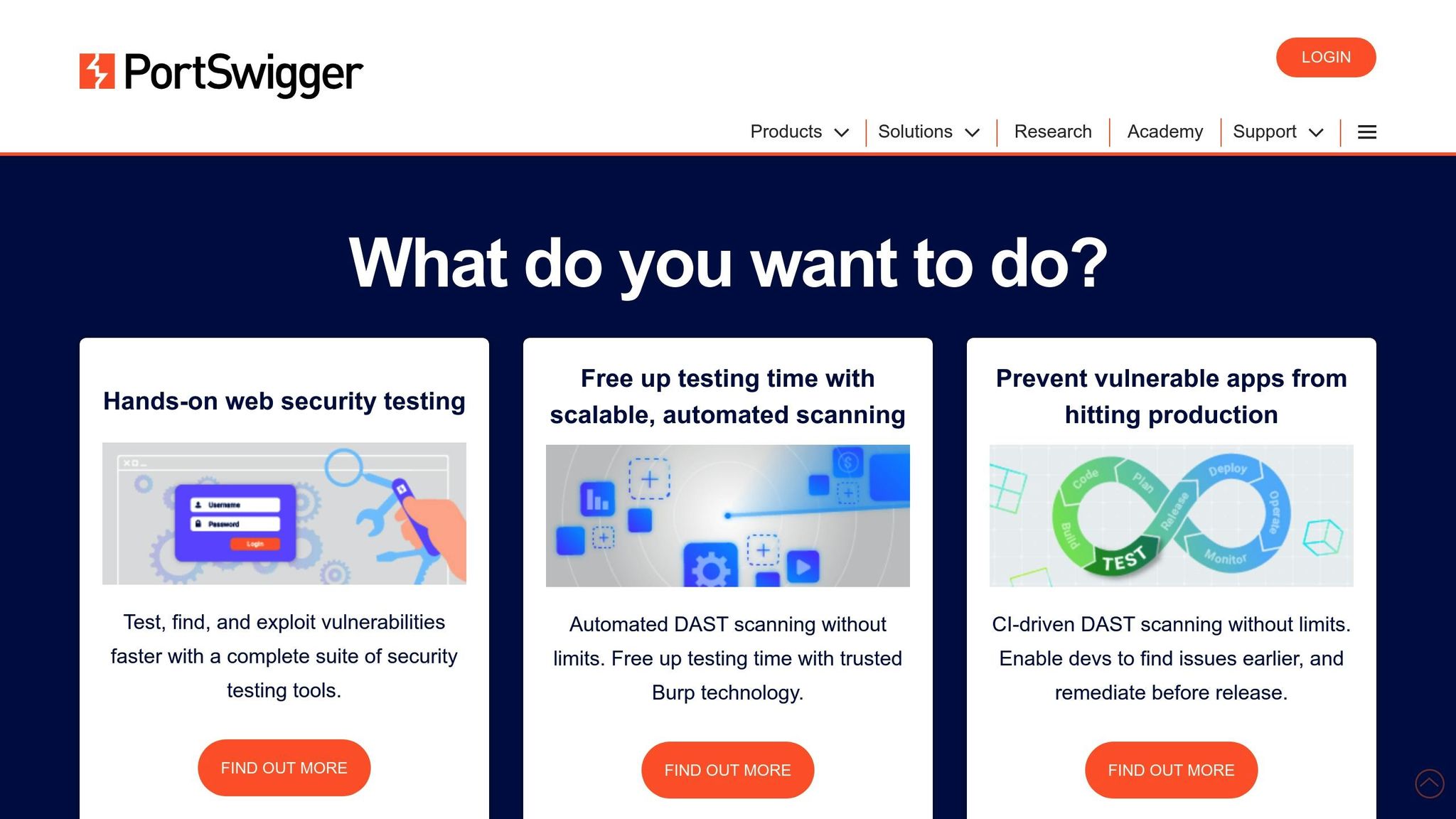Top Tools for Chatbot Security Patch Management

Effective chatbot security patch management is crucial to protect against cyber threats, ensuring compliance and maintaining user trust.
Chatbots are increasingly targeted by cyberattacks, with 73% of consumers concerned about data privacy. Managing security patches is essential to prevent breaches, comply with regulations, and maintain trust. Tools like Acunetix, Rapid7 InsightVM, AlienVault USM, Burp Suite, and custom-built solutions can help businesses automate patching, integrate with systems, and meet compliance needs.
Key takeaways:
- Automation is critical: Time-to-exploit has dropped to just 5 days in 2024, making manual patching impractical.
- Integration matters: Tools should work seamlessly with your CI/CD pipelines and third-party apps.
- Compliance support: Real-time reporting and audit trails are essential for industries like healthcare and finance.
- Top tools: Options range from Acunetix for vulnerability scans to Rapid7 for real-time monitoring, with custom tools offering flexibility for technical teams.
Quick Comparison:
| Tool | Starting Price | Key Feature | Best For |
|---|---|---|---|
| Acunetix | $4,500 | Web vulnerability scanning | Web-based chatbot security |
| Rapid7 InsightVM | $19/GB | Real-time risk monitoring | Continuous security for large datasets |
| AlienVault USM | $1,075/month | Unified security with SIEM | Small businesses needing integration |
| Burp Suite | Varies | Manual API security testing | Advanced, detailed analysis |
| Custom Tools | Variable | Tailored solutions for unique needs | Budget-conscious teams with expertise |
Pro tip: Combine automated scans with manual testing for thorough protection. Regular audits and threat modeling can further minimize risks.
Key Features to Look for in Security Patch Management Tools
When choosing a security patch management tool for your chatbot, it's crucial to focus on features that align with the specific needs of conversational AI. The best tools combine automation, seamless integration, and strong compliance capabilities to ensure your chatbot remains secure and operational.
Automated Vulnerability Scanning and Patch Deployment
With the average time-to-exploit shrinking to just five days in 2024 - a sharp drop from 32 days in 2023 - automation is no longer optional. The National Vulnerability Database logged nearly 40,000 Common Vulnerabilities and Exposures (CVEs) in 2024, reflecting a 39% increase from the previous year. This sheer volume makes manual approaches impractical.
Security tools must automate the entire patch management process, from identifying vulnerabilities to testing and deploying updates. Real-time scanning and AI-driven risk assessment are essential, as they can analyze system configurations, prioritize critical patches, and even predict potential vulnerabilities. Additionally, look for tools that support a variety of operating systems and third-party applications to cover all bases.
Integration with Business Applications and CI/CD Pipelines
Smooth integration with your existing systems is key to maintaining workflow continuity. The best solutions connect directly to your business applications and development pipelines, ensuring that security updates don’t disrupt day-to-day operations. This is especially important given that 40–80% of code in new software projects originates from third-party sources, often open-source components.
Effective tools should automate tasks like vulnerability detection, prioritization, and testing. They must also deploy patches seamlessly while preserving system stability. Integration features often include monitoring, alerting, and maintaining detailed patch inventories. Additionally, tools with rollback procedures provide an extra layer of security if something goes wrong.
Compliance Support and Reporting
For industries like healthcare and finance, regulatory compliance is a critical consideration. Security tools must provide real-time visibility and customizable reports that align with industry standards. This includes creating audit trails that document patch application timelines, addressed vulnerabilities, and response times to security threats.
Robust reporting features go beyond compliance checklists by offering actionable insights into your security performance. For instance, they can help track patch deployment success rates, identify recurring vulnerabilities, and evaluate the overall effectiveness of your security measures. Tools should also simplify compliance by automatically generating documentation for audits, reducing the administrative workload for your team. Prompt support for deployment issues is another essential feature to consider.
Top Tools for Chatbot Security Patch Management
Managing chatbot security patches can be a complex task, especially for small businesses aiming to maintain secure operations. Fortunately, several tools are available that cater to specific patch management needs. Below is a rundown of some of the top options, highlighting their key features and strengths.
Acunetix

Acunetix is a standout tool for web application security testing, offering detailed vulnerability assessments tailored for web-based chatbot deployments. It automatically scans for common vulnerabilities like SQL injection, cross-site scripting, and authentication bypasses. With a likelihood-to-recommend rating of 9.0/10 and pricing starting at $4,500, Acunetix enables organizations to identify and address security flaws efficiently, keeping their chatbot operations secure.
Rapid7 InsightVM

Rapid7 InsightVM provides real-time monitoring combined with an intuitive interface, making it a favorite among security teams. It delivers live vulnerability data and continuous monitoring, allowing businesses to prioritize patches based on actual risk levels rather than generic severity scores. With a usability rating of 9.0/10 and pricing starting at $19 per GB, this tool is ideal for businesses handling varying data volumes while maintaining strong security measures.
AlienVault USM
AlienVault USM offers a unified approach to security management by combining vulnerability detection with SIEM (Security Information and Event Management) capabilities. This makes it an excellent choice for small businesses seeking a comprehensive solution without juggling multiple tools. With over 350 plugins for seamless integration with other security solutions and cloud services, AlienVault simplifies operations. Starting at $1,075 per month, it has usability and support ratings of 6.7/10 and 7.3/10, respectively, providing a centralized option for businesses needing integrated security coverage.
Burp Suite

Burp Suite is designed for organizations that require advanced security testing for APIs and web interfaces, which are critical components of chatbot functionality. Known for its manual penetration testing capabilities, Burp Suite allows security professionals to thoroughly examine chatbot endpoints and communication protocols. While it requires a higher level of technical expertise, its ability to perform in-depth analysis makes it indispensable for teams with sophisticated security needs.
Custom Security Audit Tools
For businesses with specific requirements or tighter budgets, custom security audit tools offer a flexible and cost-effective alternative. With open-source components making up 70–90% of most applications, these tools are particularly useful for addressing vulnerabilities in chatbot systems with significant open-source dependencies. Custom solutions enable teams to tailor scanning parameters, reports, and integration points to meet unique compliance and security needs. While they require technical expertise and ongoing maintenance, combining open-source scanners with custom scripts can provide effective protection at a lower cost.
| Tool | Starting Price | Key Feature | Best For |
|---|---|---|---|
| Acunetix | $4,500 | Web application security testing | Comprehensive vulnerability assessment |
| Rapid7 InsightVM | $19 per GB | Real-time monitoring and intuitive interface | Continuous security monitoring |
| AlienVault USM | $1,075/month | Unified security management with SIEM | Small businesses needing integrated security |
| Burp Suite | Varies | Manual penetration testing for APIs | In-depth security analysis |
| Custom Tools | Variable | Full customization and flexibility | Budget-conscious teams with technical skills |
These tools cater to a range of security needs, from automated vulnerability scans to fully customized solutions, ensuring businesses can safeguard their chatbot deployments effectively.
Comparison of Security Patch Management Tools
Choosing the right security patch management tool hinges on your business priorities, technical expertise, and budget. Based on the key features discussed earlier, this comparison dives into how these tools align with specific technical and operational requirements. The main differences often come down to integration, automation, and overall cost, which can significantly influence your decision-making.
Integration with Existing Systems
For small businesses, seamless integration with existing systems is often a top priority. The 2024 Global DevSecOps Survey from GitLab reveals that while 56% of developers release code multiple times daily, only 29% have fully integrated security into their DevOps workflows. This underscores the importance of tools that blend effortlessly into current processes to maintain security without disrupting operations.
- Acunetix delivers thorough vulnerability assessments but demands technical expertise for integration into CI/CD pipelines.
- Rapid7 InsightVM offers a clear advantage with real-time monitoring and built-in integrations. Its ability to connect with existing business tools and provide continuous vulnerability insights makes it a strong choice for businesses handling diverse data loads. The intuitive interface also simplifies deployment.
- AlienVault USM excels with its unified approach to security management. Boasting over 350 integration plugins, it combines vulnerability detection with SIEM capabilities, creating a centralized solution.
Automation Capabilities
Automation is another area where tools vary widely.
- Burp Suite requires significant manual input, making it better suited for organizations with dedicated security teams capable of handling detailed analyses.
- On the other hand, custom security audit tools provide flexible automation options, enabling businesses to design tailored processes that meet their unique security needs.
Deployment Speed
In fast-paced CI/CD workflows, deployment speed can make or break a security strategy. For instance, catching a misconfigured access control policy during development can lead to a quick fix within hours. However, if the issue is discovered post-release, it might take weeks to address, potentially eroding customer trust. Tools that integrate seamlessly into development pipelines enable faster remediation, reducing the likelihood of security issues reaching production.
Compliance and Ease of Use
For businesses in regulated industries like healthcare, finance, or legal sectors, compliance support is non-negotiable. Tools offering automated reporting and policy enforcement not only simplify regulatory adherence but also cut down on administrative tasks.
- Companies with limited technical resources may find AlienVault USM appealing due to its comprehensive coverage and minimal setup requirements.
- Meanwhile, organizations with specialized security teams might prefer more advanced solutions like Burp Suite or custom tools, which provide deeper analysis and greater flexibility.
Best Practices for Chatbot Security Maintenance
To keep chatbots secure, a combination of regular audits, testing, and proactive strategies is essential. These practices not only reinforce security but also help businesses address both existing and emerging threats effectively.
Schedule Regular Security Audits
Security audits are a critical part of maintaining a secure chatbot environment. Companies that perform frequent audits are 50% less likely to face severe data breaches compared to those that don't prioritize them. Considering that over 60% of businesses experience data breaches annually, skipping audits isn't an option.
Audits should be scheduled quarterly, after major updates, or following any security incidents. This proactive approach helps identify vulnerabilities before they can be exploited. For context, 80% of web applications have at least one exploitable vulnerability, as reported by API security firm 42Crunch.
Here’s a quick breakdown of audit types and their recommended frequency:
| Assessment Type | Frequency | Key Focus Areas |
|---|---|---|
| Vulnerability Scans | Quarterly | System and dependency checks |
| Penetration Testing | Annual | Identifying exploitable flaws |
| Code Reviews | Ongoing | Auditing custom integrations |
By scheduling audits, patch updates, and data refreshes proactively, businesses can quickly detect and address issues. These efforts form the foundation of a well-rounded testing strategy.
Combine Automated and Manual Testing
A balanced testing approach is essential - neither automated nor manual testing alone can fully secure your chatbot. Combining the two ensures comprehensive coverage and minimizes the risk of overlooked vulnerabilities.
- Automated Testing: Tools like scanners can run daily or weekly checks, identifying potential issues quickly and consistently without human input. However, they may miss complex vulnerabilities.
- Manual Testing: Penetration testing simulates real-world attacks, relying on skilled experts to uncover deeper, more nuanced security issues.
Here’s a comparison of these two approaches:
| Feature | Vulnerability Assessment (VA) | Penetration Testing |
|---|---|---|
| Focus | Identifies and prioritizes vulnerabilities | Exploits vulnerabilities to assess impact |
| Tools Used | Automated scanners | Security experts and advanced techniques |
| Depth | Broad overview of weaknesses | In-depth analysis of exploitable flaws |
| Frequency | Daily or weekly | Monthly, quarterly, or annually |
| Outcome | Reports on vulnerabilities and severity | Detailed remediation strategies |
Start with automated scans to flag obvious vulnerabilities. Then, dive deeper with manual testing to simulate complex attack scenarios. Finally, compile a report that outlines methods used and the severity of any discovered weaknesses.
Implement Threat Modeling Frameworks
Threat modeling takes a proactive look at your chatbot's security by analyzing it from an attacker's perspective. This structured process can identify potential risks and vulnerabilities early in development, preventing them from escalating into real problems.
The process involves several key steps:
- Mapping your chatbot's architecture and interactions.
- Identifying potential threats.
- Assessing risks and devising mitigation strategies.
Tools and frameworks like STRIDE and PASTA can help automate threat identification and risk management. These methodologies provide a systematic way to evaluate vulnerabilities and develop countermeasures.
For example, Nagarro conducted grey box model penetration testing for a workforce management chatbot integrated with MS Teams. The testing revealed vulnerabilities, and the subsequent report offered actionable fixes, securing sensitive user data.
Threat modeling shouldn't be a one-time exercise. As your chatbot evolves and new threats emerge, regular sessions will help you stay ahead by continuously refining your security measures.
Conclusion
Managing patches effectively is a cornerstone of a strong security strategy, especially as cyber threats continue to evolve. The numbers speak for themselves: 73% of breaches in 2025 were linked to unpatched vulnerabilities, highlighting the critical need for automated patch management solutions.
The tools discussed - ranging from Acunetix to Rapid7 - demonstrate real-world impact. For instance, intrusion detection systems can lower the rate of successful attacks by 30%, while automated responses significantly reduce incident resolution times by 52%.
Automation and integration are essential components of this process. As Robert Sheldon explains:
By adopting automated tools, businesses can simplify this intricate process while maintaining full visibility into their security systems.
The cost of neglecting patch management is steep. Back in 2019, 60% of breaches were caused by unpatched vulnerabilities. Fast forward to 2025, and the global patch management market is expected to hit $950 million, reflecting a growing awareness of the need for robust security investments.
For businesses utilizing AI-powered tools like Dialzara's virtual phone answering service, security takes on an even greater significance. These systems manage sensitive customer information, handle appointment scheduling, and facilitate business communications around the clock. A breach in such systems could erode customer trust and lead to regulatory challenges.
To stay ahead, focus on solutions that integrate smoothly with your existing systems, offer real-time monitoring, and provide detailed reporting. Remember, technology alone isn’t enough - invest in training your team to use these tools effectively. Balancing the right technology with skilled personnel is the key to a secure and resilient operation.
FAQs
What should I look for in a chatbot security patch management tool?
When you're choosing a chatbot security patch management tool, focus on features that make managing security easier and more effective. Look for tools that provide automated vulnerability detection, quick patch deployment, and compatibility across multiple platforms. These essentials ensure your chatbot remains secure and operates smoothly.
To take it a step further, consider tools with real-time alerts and compliance monitoring. These features help you stay informed and ensure your chatbot meets necessary security standards. For businesses aiming to stay ahead of potential threats, advanced options like AI-powered threat prediction and ongoing security audits are invaluable. These capabilities play a critical role in safeguarding your chatbot against ever-changing risks and maintaining its reliability.
How do automation and integration in security tools help address vulnerabilities faster?
Automation and integration in security tools empower businesses to identify, rank, and address vulnerabilities as they happen, cutting down the chances of exploitation. By taking over repetitive tasks, automation speeds up responses to new threats and helps eliminate mistakes caused by human oversight.
When systems work together seamlessly, workflows become more efficient. Integrated tools ensure smooth communication between different platforms and teams, making it easier to apply crucial security patches quickly. This reduces the time attackers have to exploit weaknesses, keeping your systems safer.
Why is compliance support crucial for chatbot security in industries like healthcare and finance?
Compliance support plays a critical role in ensuring chatbot security, especially in tightly regulated sectors like healthcare and finance. It helps organizations adhere to laws such as HIPAA and other data protection regulations, which are designed to protect sensitive customer information. Beyond legal obligations, this reduces the risk of data breaches, legal penalties, and damage to a company’s reputation.
When businesses prioritize compliance, they demonstrate a commitment to safeguarding personal and financial data. This not only builds trust and confidence among users but also reinforces customer loyalty over time. Additionally, strong compliance measures establish clear security protocols, ensuring that chatbots meet industry standards while maintaining secure and reliable operations.
Ready to Transform Your Phone System?
See how Dialzara's AI receptionist can help your business never miss another call.